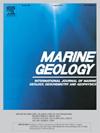“斑马”测年:渐新世末期陆基到超浅海罗蒙诺索夫海岭?
IF 2.2
3区 地球科学
Q2 GEOSCIENCES, MULTIDISCIPLINARY
引用次数: 0
摘要
在IODP第302远征队(ACEX)前往北冰洋中部罗蒙诺索夫海脊20年后,一个可靠的年龄模型仍然缺乏。这主要是由于整体上较差的岩心恢复,以及经常缺乏年龄诊断特征,包括(微)化石,特别是在可能的新近纪演取中。有趣的是,为数不多的几个相对较好的恢复区间之一被解释为跨越古近系-新近系过渡。船上和后续的海洋孢粉学研究表明,在这段时间内,古近纪(~ 44 Ma)的局部顶部与新近纪(~ 18 Ma)之间可能存在~ 26 Myr长的间隙,发生在局部岩性亚单位1/6和1/5之间。后者也被非正式地称为“斑马”间隔,因为其特征是沉积物颜色的黑/白交替。这一断裂带可能暗示渐新世晚期至中新世早期存在陆基或超浅海罗蒙诺索夫海岭。“斑马”亚基1/5的新发现(晚)中新世早期,我们将其命名为Arcticacysta,其中包括A. backmanii和A. moraniae两种,这初步提供了一个新的、后来正式描述的有机壁甲藻囊(dinocyst)属。随后的工作挑战了中断的存在和“斑马”亚单位的年龄。本文介绍了IODP 374考察(南极洲罗斯海)期间从Pennell盆地中新世沉积物中获得的孢粉学(dinocyst)发现,在17.7 Ma时首次出现了相同的dinocyst属、arcacysta和物种的标本,并在17.0至15.9 Ma之间持续存在。考虑到该恐龙属的首次出现在两个极地记录中是同步的,这些发现证实了北冰洋“斑马”间隔的定位是早中新世(晚),并为罗蒙诺索夫海岭古近纪/新近纪过渡的大间断提供了证据。本文章由计算机程序翻译,如有差异,请以英文原文为准。
Dating ‘Zebra’: A subaerial to ultra-shallow marine Lomonosov Ridge at the end of the Oligocene?
Twenty years after the pioneering IODP Expedition 302 (ACEX) to the Lomonosov Ridge, central Arctic Ocean, a robust age model was still lacking. This was foremost due to the overall poor core recovery, and frequent lack of age diagnostic features including (micro)fossils, notably in the likely Neogene succession. Interestingly, one of the few intervals that were relatively well-recovered was interpreted to span the Paleogene-Neogene transition. On board and follow up marine palynological studies indicated that within this interval, a potential ∼26 Myr long hiatus separated the local top of the Paleogene (∼44 Ma) from the Neogene (∼18 Ma), occurring between local lithological subunits 1/6 and 1/5. The latter was informally also referred to as the ‘Zebra’ interval, owing to its characteristic black/white alternations in the colour of the sediments. This hiatus would possibly imply a subaerial or ultra-shallow marine Lomonosov Ridge during late Oligocene to early Miocene times. A Neogene, (late) Early Miocene age for the base of ‘Zebra’ subunit 1/5 was tentatively provided by the finding of a new, later formally described, organic walled dinoflagellate cyst (dinocyst) genus we named Arcticacysta, which included two species, A. backmanii and A. moraniae. Subsequent work challenged the presence of a hiatus and the age of the ‘Zebra’ subunit.
Here we present recent palynological (dinocyst) findings from Miocene sediments retrieved from the Pennell Basin during IODP Expedition 374 (Ross Sea, Antarctica) that contain the first appearance at 17.7 Ma of specimens of the same dinocyst genus, Arcticacysta, and species, and a more continuous presence between 17.0 and 15.9 Ma. Providing that the (first) occurrence of this dinocyst genus is synchronous in both (polar) records, these findings confirm the assignment of the Arctic Ocean ‘Zebra’ interval to the (late) Early Miocene, adding evidence for a large hiatus characterizing the Paleogene/Neogene transition on the Lomonosov Ridge.
求助全文
通过发布文献求助,成功后即可免费获取论文全文。
去求助
来源期刊

Marine Geology
地学-地球科学综合
CiteScore
6.10
自引率
6.90%
发文量
175
审稿时长
21.9 weeks
期刊介绍:
Marine Geology is the premier international journal on marine geological processes in the broadest sense. We seek papers that are comprehensive, interdisciplinary and synthetic that will be lasting contributions to the field. Although most papers are based on regional studies, they must demonstrate new findings of international significance. We accept papers on subjects as diverse as seafloor hydrothermal systems, beach dynamics, early diagenesis, microbiological studies in sediments, palaeoclimate studies and geophysical studies of the seabed. We encourage papers that address emerging new fields, for example the influence of anthropogenic processes on coastal/marine geology and coastal/marine geoarchaeology. We insist that the papers are concerned with the marine realm and that they deal with geology: with rocks, sediments, and physical and chemical processes affecting them. Papers should address scientific hypotheses: highly descriptive data compilations or papers that deal only with marine management and risk assessment should be submitted to other journals. Papers on laboratory or modelling studies must demonstrate direct relevance to marine processes or deposits. The primary criteria for acceptance of papers is that the science is of high quality, novel, significant, and of broad international interest.
 求助内容:
求助内容: 应助结果提醒方式:
应助结果提醒方式:


